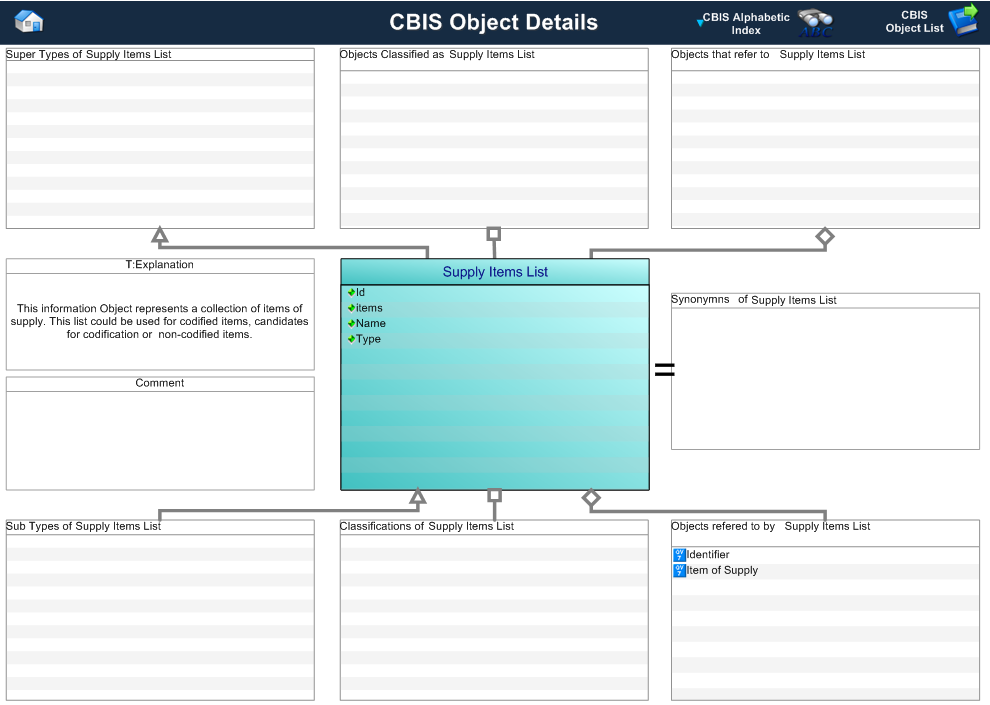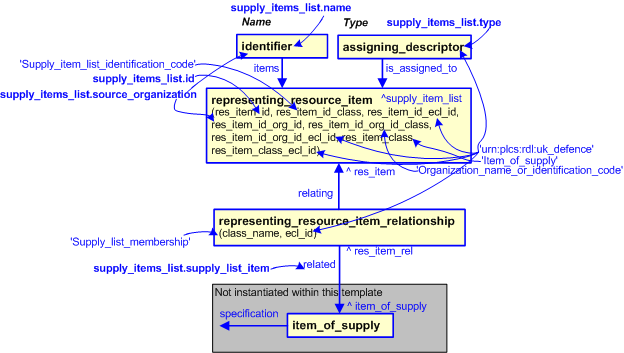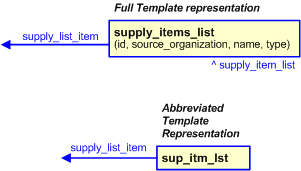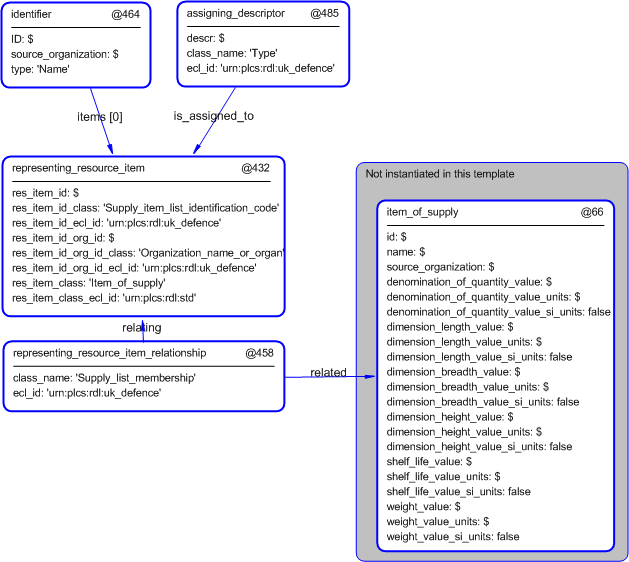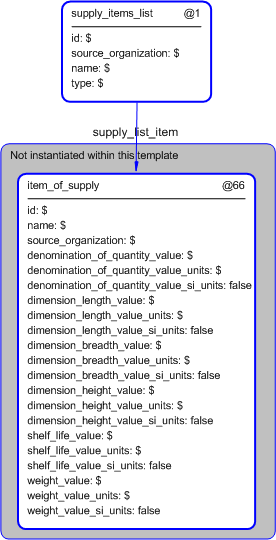Template:— supply_items_list (sup_itm_lst)
Context:— UK_Defence |
Date: 2010/03/15 13:38:27
Revision: 1.7
|
This section specifies the template supply_items_list.
NOTE
The template has been defined in the context of
UK_Defence.
Refer to the business context for details of related templates.
NOTE
An explanation of a template and the associated instantiation path is
provided in the
Template overview
section.
This template describes how to represent a collection of items of supply.
This information object represents a collection of items of supply. This list could be used for codified items, candidates
for codification or non-codified items
Figure 1 — Graphical Representation for Business Object supply_items_list
The definition of a supply_items_list object is: a collection of items of supply. This list could be used for codified
items, candidates for codification or non-codified items
|
Attribute name
|
Attribute description
|
Attribute type
|
Optionality
|
| Id |
This is the identifier of the supply items list. |
Identifier |
Mandatory |
| Identifier.id |
This is the value of the id attribute of the Identifier applied to the supply items list. |
intrinsic |
Mandatory |
| Identifier.type |
This attribute is the type associated with the id of the Identifier given to the supply items list. |
supply_items_list_id_code |
Mandatory |
| Identifier.source_organization |
This attribute is the value representing the source organization that provides the id of the Identifier given to the supply
items list. This value is assumed to be a type of Organization_name_or_identification_code.
|
Organization_name_or_identification_code |
Mandatory |
| Items |
This is a reference to the items (Item of Supply) in the list. |
Relationship to Item_of_supply |
Mandatory (1:?) |
| Name |
This is the name of the supply items list. |
intrinsic |
Mandatory |
| Type |
This is a description of the type of supply item list. |
intrinsic |
Mandatory |
Table 1 — supply_items_list attribute details
The EXPRESS-G diagram in
Figure
2
shows the templates and EXPRESS entities that are required
to represent the template
"supply_items_list".
The text highlighted in blue shows the template parameters.
Figure 2 — An EXPRESS-G representation of the Information model for supply_items_list
The graphic for the template to be used in other EXPRESS-G diagrams
is shown in Figure
3
below.
Figure 3 — The graphical representation of the supply_items_list template
The following input parameters are defined for this template:
This is the identifier of the supply item list.
The organization or information system that created the associated identifier. Alternatively this could be set to /NULL when
Person or Information System is the source; see Identifier template characterizations.
This is the name of the supply item list.
This is a description of the type of supply item list.
An item in the list. Note a new instance of this template is required to relate more than one item at a time.
The following reference parameters are defined for this template:
Allow the
Resource_item
entity instantiated in this path to be referenced when this template is used.
Note: The
Resource_item
entity can be referenced in a template path by:
%^target = $supply_items_list.supply_item_list%
where
target
is the parameter to which the
Resource_item
is bound.
This reference parameter provides a reference to the Resource_item that represents the head (or top) of the list itself. There
is one unique Resource_item for each list.
The following parameter combinations specify a uniqueness constraint:
Unique constraint: Supply_item_list_id_rule
Each instance of the
entity
(
Resource_item)
within the data set shall be uniquely identified
by a combination of the following parameters on this
template (supply_items_list) namely:
id,
source_organization,
name.
The
instance is
referenced by the following template parameter:
supply_item_list.
The instantiation path shown below specifies the entities that are to be
instantiated by the template.
A description of templates and the syntax for the instantiation path is
provided in the
Templates Help/Information section.
-- Create the relationship entity /
representing_resource_item_relationship(
class_name='Supply_list_membership',
ecl_id='urn:plcs:rdl:uk_defence')/
%^supply_list_relationship = $representing_resource_item_relationship.res_item_rel%
-- Create the Resource item to represent the head/top of the list /
representing_resource_item(
res_item_id=@id,
res_item_id_class='Supply_item_list_identification_code',
res_item_id_ecl_id='urn:plcs:rdl:uk_defence',
res_item_id_org_id=@source_organization,
res_item_id_org_id_class='Organization_name_or_identification_code',
res_item_id_org_id_ecl_id='urn:plcs:rdl:uk_defence')/
-- re-direct the output from the call %^supply_item_list = $representing_resource_item.res_item%
/
assigning_reference_data(
items=^supply_item_list,
class_name='Supply_item_list',
ecl_id='urn:plcs:rdl:uk_defence')/
-- Name /
identifier(
ID=@name,
source_organization=@source_organization,
type='Name',
items=^supply_item_list)/
/
assigning_descriptor(
descr=@type,
class_name='Supply_item_list_type',
ecl_id='urn:plcs:rdl:uk_defence',
is_assigned_to=^supply_item_list)/
-- Map the input parameters to those for rep_prom_usg, first is the top item
^supply_list_relationship.related ->
@supply_list_item
^supply_list_relationship.relating ->
^supply_item_list
The instance diagram in Figure
4
shows an example of the EXPRESS entities and templates that are instantiated by the template:
/supply_items_list(id='', source_organization='', name='', type='', supply_list_item='@66')/
(an illustration of the consolidated supply_items_list template is shown in
Figure
5 below.)
Figure 4 — Entities instantiated by supply_items_list template
The instance diagram in
Figure
5
shows the graphic symbol for the template that is to be
used in other instance diagrams. The example template is:
/supply_items_list(id='', source_organization='', name='', type='', supply_list_item='@66')/
Figure 5 — Instantiation of supply_items_list template
Characterizations
No common characterizations of the template
supply_items_list
have been identified. However, the ISO 10303-239 EXPRESS model
may enable other assignments to the entities instantiated by the template.
